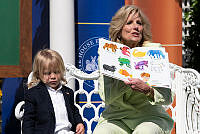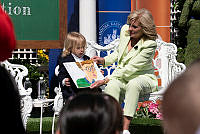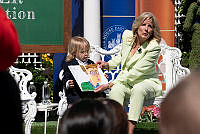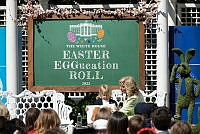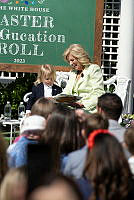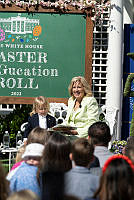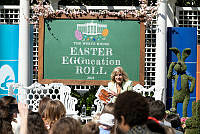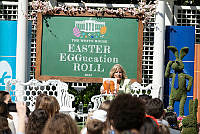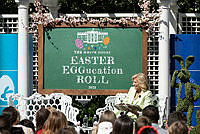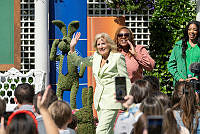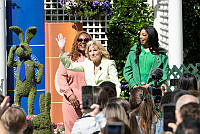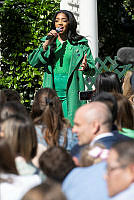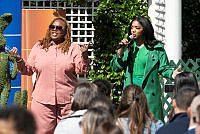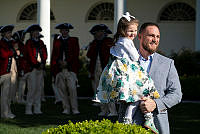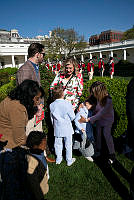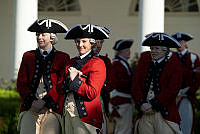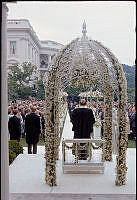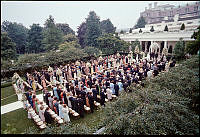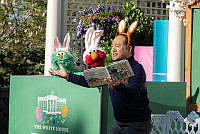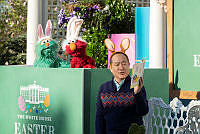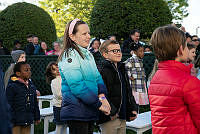Rubenstein Center Scholarship
A Celebration for Veterans
White House Garden Parties

President Warren G. Harding and First Lady Florence Harding greet veterans on June 7, 1922.
Harris & Ewing Collection, Library of CongressAt the end of World War I, over 200,000 wounded soldiers returned home to the United States. To help these veterans cope with their physical and psychological injuries, post-war presidents hosted annual garden parties at the White House. These events took place on the South Lawn and included wounded veterans from local military and naval hospitals. The veterans, along with their families and on occasion pet dogs, had the opportunity to meet the president and first lady, and enjoy an afternoon of music, dance, refreshments, and entertainment. President Woodrow Wilson and First Lady Edith Wilson hosted the first of these garden parties in the summer of 1919, but Wilson’s successor, President Warren G. Harding, and his wife, First Lady Florence Harding, made them an annual tradition that continued into the 1950s. In addition to the president and first lady, other prominent government officials helped host the veterans. General John “Blackjack” Pershing, commander of the American Expeditionary Force during World War I, was a regular attendee, as was Massachusetts Representative Edith Nourse Rogers, known as the “Angel of Walter Reed” because of her tireless advocacy for World War I veterans. The garden parties were immensely popular with the servicemen. A newspaper account of the 1922 party recounted: “[The veterans] were thrilled with the attention they received and no matter how badly wounded had radiant smiles of pleasure on their faces.”1

President Calvin Coolidge signs a bill authorizing the construction of military hospitals at the 1924 White House Garden Party. First Lady Grace Coolidge and General John "Blackjack" Pershing look on as the president signs the legislation at a desk on the White House South Lawn.
Harris & Ewing Collection, Library of CongressThe annual garden parties followed a routine every year. The 1924 party was typical: at 4:00 p.m. on June 5, 1924, 2,000 wounded veterans from the Army, Navy, and Marine Corps arrived at the White House and made their way to the South Lawn. White House staff had erected red-and-white striped tents, under which the veterans could escape from the summer heat. Forty-eight female “American beauties,” according to one Washington Post reporter, one for every state at that time, mingled among the veterans and passed out refreshments. Once all of the veterans had arrived, President Calvin Coolidge and First Lady Grace Coolidge stood beneath a large oak tree while the veterans passed by one at a time to shake their hands. Red Cross nurses and fellow veterans were also on hand to assist those who were blind or wheelchair-bound. The receiving line lasted about an hour, after which the United States Marine Band played songs popular among soldiers during World War I, including “Keep the Home Fires Burning,” “It’s a Long, Long Way to Tipperary,” and “Over There.” Some danced and others sang along to the patriotic tunes while the president and first lady mingled with the veterans and their families. Coolidge also used the occasion to sign a bill that appropriated over $6,000,000 for the construction of three military hospitals, including one devoted entirely to those blinded during their service. The veterans gathered around President Coolidge as he signed the bill, after which he presented the pen to Charles Seddon, a wheelchair-bound veteran in attendance. At 5:30 p.m., the president and first lady retired to the White House, at which point many of the veterans returned to Walter Reed General Hospital for a free showing of the play “The Great White Way,” which the president and first lady had arranged for them.2

President Calvin Coolidge and First Lady Grace Coolidge greet and shake hands with wounded veterans at the 1924 White House Garden Party.
National Photo Company Collection, Library of CongressSome of the garden parties deviated slightly from the 1924 schedule of events. President Harding and First Lady Florence scheduled “sightseeing buses and other conveyances” to take veterans around the city after the 1922 event. Tom Mix, a silent-film actor famous for his cowboy roles, was a surprise guest at the 1925 garden party. Mix dashed up the White House driveway on his horse and performed stunts to entertain the veterans. When rain threatened to derail the 1932 garden party, President Herbert Hoover opened the White House to the 1,000 veterans in attendance, most of whom took the opportunity to tour the Executive Mansion. President Franklin Roosevelt and First Lady Eleanor Roosevelt added more entertainment to their garden parties, including “an exhibition of ballroom dancing” at the 1933 party, and a musical performance by the Howard University Glee Club at the 1938 event. The 1938 party also featured a lasso expert who wowed the guests by performing “some neat tricks with the rope,” accompanied by “his own special brand of chatter.”3

President Herbert Hoover mingles with veterans at the 1929 White House Garden Party.
Herbert Hoover Presidential Library & MuseumWhile most of the veterans at the garden parties were men, some female veterans also attended, such as “two blind nurses…wounded in the course of duty” who joined the 1922 party. The majority of wounded soldiers attending the garden parties were veterans of World War I, but most occasions also had a small contingent of elderly Civil War veterans, such as J.H. Sheppard who attended the 1927 party. Sheppard had joined the Union Army at age sixteen and was wounded three times. His three sons had served in the U.S. military during World War I, with each suffering wounds of their own. At the 1927 garden party, Sheppard reportedly “engrossed” President Coolidge and First Lady Grace who “listened as the old man told of military exploits of yesterday.” The 1933 garden party hosted an 88-year-old veteran of the Civil War who claimed to have shook hands with President Abraham Lincoln and all subsequent presidents except Chester A. Arthur. Upon hearing his story, First Lady Eleanor Roosevelt stated: “If you shook hands with Lincoln, I’ll have to shake yours again.”4

President Franklin D. Roosevelt and First Lady Eleanor Roosevelt shake hands with a veteran on May 21, 1936.
Harris & Ewing Collection, Library of CongressThe first veteran garden parties hosted thousands of service members, but the number of guests dwindled every year to a few hundred by the end of the 1930s. A newspaper account of the 1929 party noted this trend: “From year to year the pitiful line of war casualties grows shorter, as some pass beyond suffering and more and more are rehabilitated to resume their active place in the world.” Still, the White House continued to host the parties through 1941, when the United States’ entry into World War II brought them to an abrupt but temporary end. President Harry S. Truman revived the annual garden parties during his administration, and expanded the guest list to include veterans from World War II, the Korean War, and even the Spanish American War. President Dwight Eisenhower kept the tradition alive by hosting three more parties during his tenure in the White House. He threw parties in 1953, 1955, and the final garden party in 1956 (the 1954 party was rained out). In 1953, Eisenhower invited former first lady Edith Wilson, the hostess of the first-ever veteran garden party in 1919, to help him greet guests.5 Although garden parties for veterans are no longer an annual tradition, presidents continue to regularly host events at the White House for veterans and their families, as well as visit wounded soldiers at various military hospitals.

President Harry Truman shakes hands with an Army Nurse Lieutenant at a White House Garden Party for veterans on May 23, 1946.
ACME Newspictures, Harry S. Truman Presidential Library & Museum













